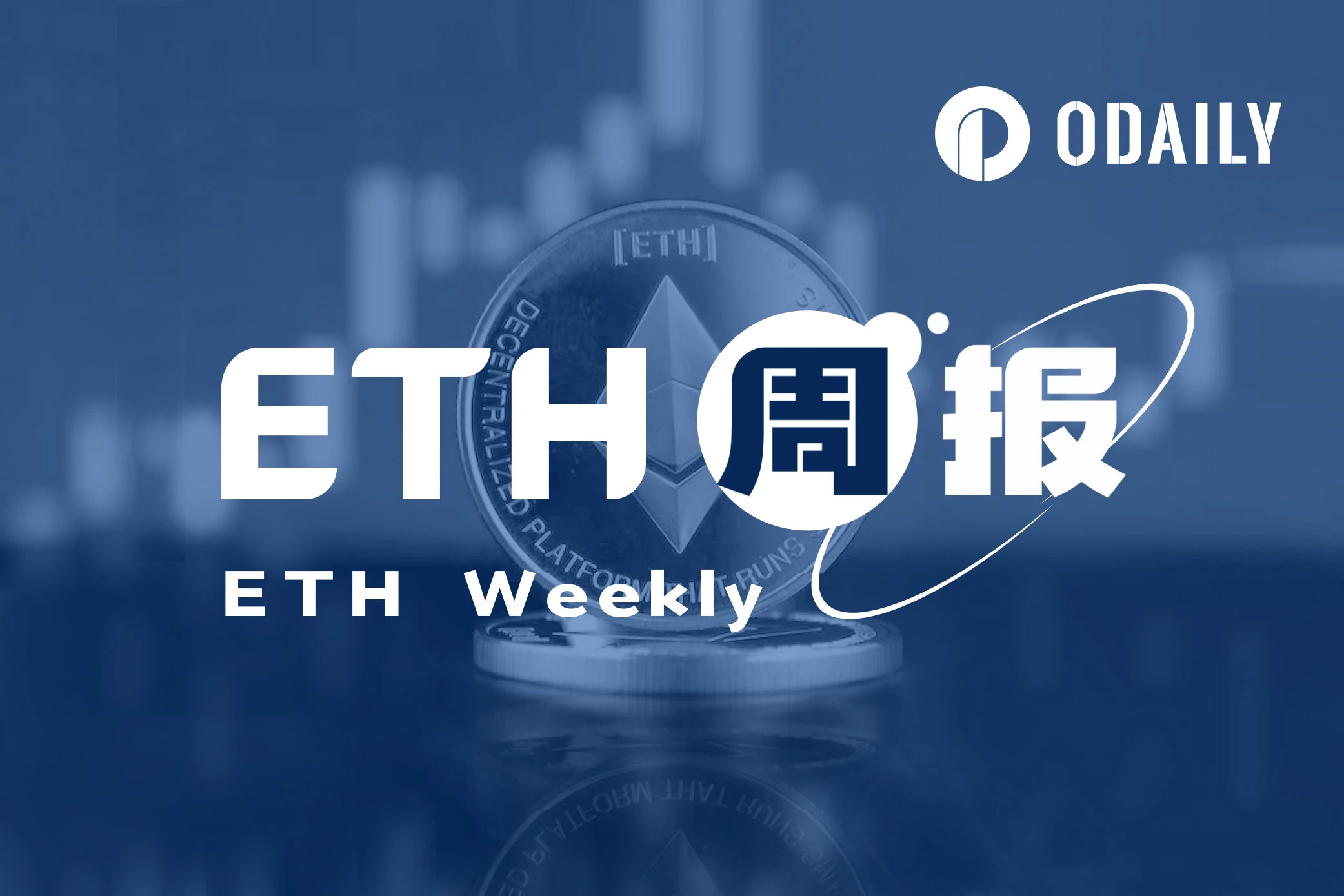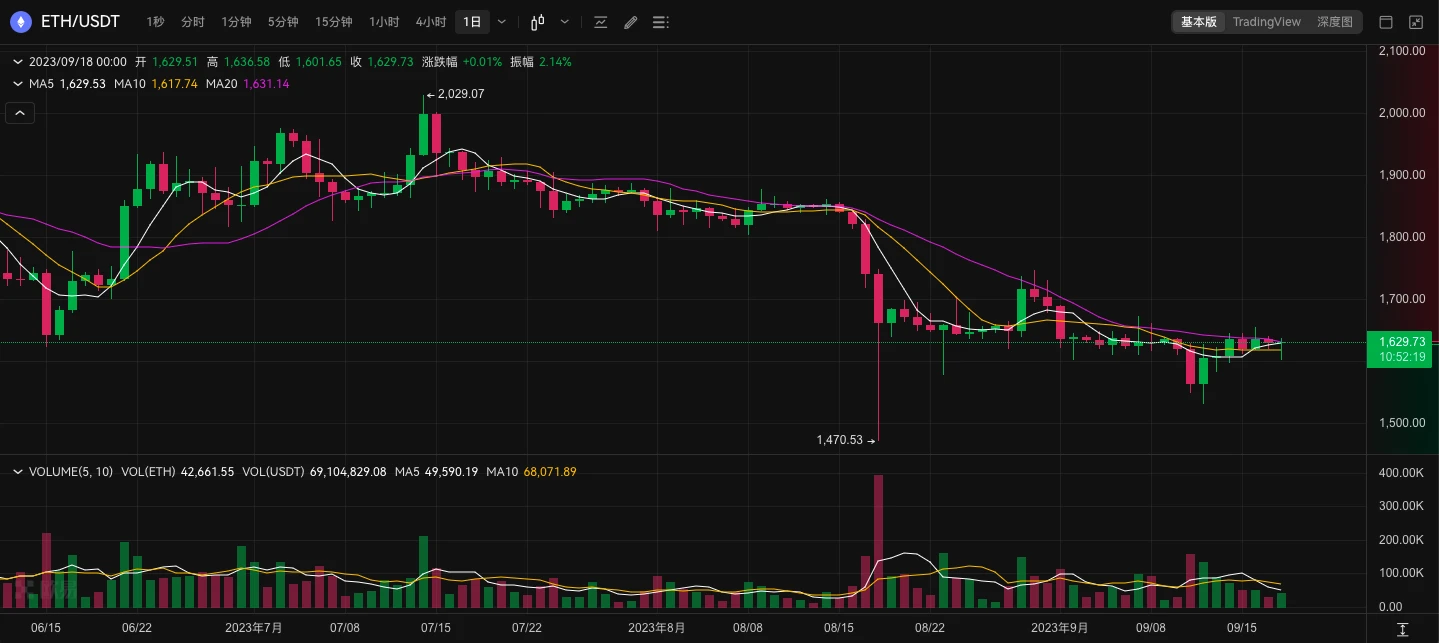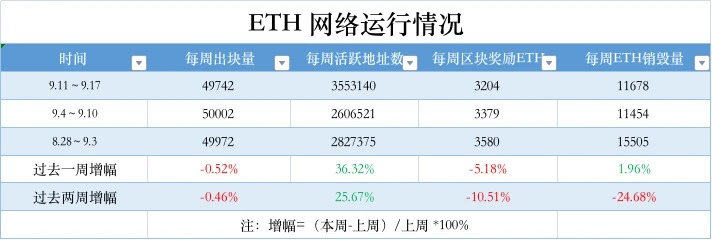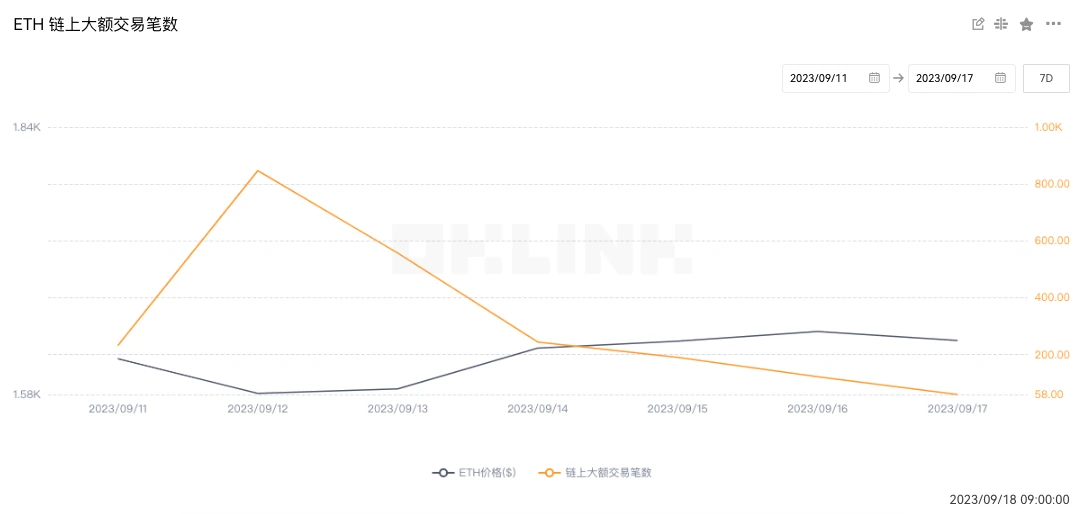Organizing | Odaily Planet Daily
Author | Qin Xiaofeng

I. Overview
On September 15, the Ethereum Holesky testnet was officially launched, which will replace the current Goerli testnet. Subsequently, Christine Kim, Vice President of Galaxy Research, stated that the Holesky testnet failed to start due to network configuration errors, and developers will restart it as soon as possible. The latest news is that developers will relaunch Holesky within a week, with the planned time being September 22. Ethereum developer Michael Sproul revealed in a pull request on GitHub that the expected relaunch time is September 28.
Bloomberg ETF analyst James Seyffart stated on X platform that the crypto asset management company Hashdex has submitted an application for a spot Ethereum ETF. It is reported that Hashdex has a management scale of 435 million USD.
In the secondary market, the price of ETH may continue to consolidate in the short term, with support at 1600 USD and resistance at 1650 USD.
II. Secondary Market
1. Spot Market
Data from OKX Market shows that last week, ETH fell to 1550 USDT at one point and closed at 1629 USDT for the week, a 1% increase from the previous week.

ETH daily chart, from OKX
The daily chart shows that the price is currently consolidating around 1630 USD, with support at 1600 USD. If it falls below, it may further decline to 1500 USD; the resistance level is at 1650 USD.
2. Network Operation

Data from Etherscan shows that the Ethereum network produced 49,742 blocks in the past week, a 0.5% decrease from the previous week; the number of active addresses per week was 3,553,140, a 36.3% increase from the previous week; block reward income was 3,204 ETH, a 5.1% decrease from the previous week; and the weekly ETH burn reached 11,678, a 2% increase from the previous week.
Data from ultrasound.money shows that since the Ethereum merge upgrade in mid-September last year, over 680,000 ETH have been issued and over 980,000 ETH have been burned, resulting in a decrease in net supply of nearly 300,000 ETH; calculated as an annual percentage, the supply has decreased by 0.249%.
3. Large Transactions

Data from OKLink shows that the number of large on-chain transactions reached 2,244 last week, a 116.6% increase from the previous week (1,036), indicating a significant increase in whale trading activity.
4. Wealthy Address List

Data from OKLink shows that the total deposit amount of ETH 2.0 has reached 26.87 million ETH, with a staking rate of 22.35%; in terms of the distribution of ETH holding addresses, the proportion held by exchanges is 8.58%, a 0.05% increase from the previous period; DeFi projects account for 30.78%, a 0.23% increase from the previous period; the proportion of large addresses (top 1000 addresses excluding exchanges and DeFi projects) is 29.38%, a 0.01% decrease from the previous period; and other addresses account for 31.26%, a 0.27% decrease from the previous period.
5. Lock-up Data
Data from DeFiLlama shows that the on-chain locked collateral value increased from 21.26 billion USD to 21.33 billion USD last week, a slight increase of 0.5% from the previous period; the top three locked values for individual projects are: Lido at 14.16 billion USD; MakerDAO at 4.96 billion USD; Aave at 3.97 billion USD.
III. Ecosystem and Technology
1. Technological Progress
Ethereum core developer Tim Beiko summarized the latest Ethereum core developer execution meeting (ACDE) on X platform. The meeting introduced Devnet updates, new content for Dencun upgrade, and provided a comprehensive overview of Reth:
- Devnet-8 status update: The network is about to be completed, and many clients have started pushing new updates to it. At the same time, the developer tool system Kurtosis has started testing MEV/block construction processes. Nethermind shared that their blob transaction pool is ready, and after testing on a single node for several days, it has been deployed on all Dencun test nodes. Geth's blob transaction pool is also nearing completion. Besu is conducting a more extensive check of its transaction pool (to limit the size of Blob+non-Blob transactions), and is expected to be released in the next version. Erigon is still developing its pool, hoping to be ready for devnet-9.
- Discussion on whether to add a constant upper limit to the validator activation queue. This proposal was formally named EIP-7514 (adding a maximum epoch loss limit). In the worst case, this will slow down the growth rate of ETH staking percentage.
- Adding an opcode in EVM to expose the basic cost of blob. We have a similar opcode that exposes the BaseFee of EIP-1559, which was introduced at the same time as the EIP activation. This makes it easier for L2 to determine the correct gas price to charge users based on L1 data costs.
- The meeting discussed some updates to EIP-4788, which store the beacon root in the contract on EL. The contract has undergone multiple audits and fuzz testing, resulting in some minor changes described in this PR. The first change is to explicitly handle a 0 timestamp, causing it to roll back (similar to other invalid timestamps) rather than return 0. The second change is the buffer size. Assuming the slot time changes, considering the working principle of modulo operations, the original contract would cause storage waste. By using a prime number (8191), 100% of the buffer should be used regardless of the slot time. Finally, gas optimization was performed, reducing the number of times CALLDATA needs to be loaded. Auditors will review these changes, and a final report is expected to be received before the next ACDE. To ensure smooth fuzz testing and implementation, developers agreed to merge the proposed changes now.
- Discussion on how clients should handle system contract addresses that are part of the state but are empty at the end of execution. Although this is actually impossible on the mainnet, it is an edge case that appeared in testing by setting addresses at genesis. Considering the special nature of this edge case and the lack of clear specified behavior, developers agreed to spend more time thinking about this issue and continue the discussion in the testing call on Monday.
2. Community Voices
Vitalik Buterin stated at the Permissionless conference that crypto-based solutions have the potential to be more decentralized, privacy-protecting, and secure than the current Web2 environment. He mentioned cases such as ENS, POAP, and Gitcoin Passport. Vitalik expressed that Ethereum's dream is to truly create an independent open technology stack that can compete with companies like Google and Twitter.
Vitalik envisioned a gradual process where new Web3 users create an Ethereum address, initially controlled by services like Gmail, but using account abstraction to allow people to take ownership when they are ready to use more native cryptographic methods.
Vitalik stated that people have the opportunity to step down from the decentralized ladder and then truly enter this completely independent stack, where all the different parts can actually work together. (Blockworks)
Ethereum core developer and EIP-1559 co-author eric.eth stated on X platform: "friend.tech will never surpass traditional social media, because ordinary people won't spend $2000 to read your terrible content. We are all in a speculative crypto bubble, which is fine for friend.tech, but please don't pretend it will become the next Twitter (now named X)."
3. Project Trends
(1) Ethereum Holesky Testnet Officially Launched
On September 15, the Ethereum Holesky testnet was officially launched, which will replace the current Goerli testnet. Subsequently, Christine Kim, Vice President of Galaxy Research, stated that the Holesky testnet failed to start due to network configuration errors, and developers will restart it as soon as possible.
Blockchain tools and infrastructure developer Nethermind stated that developers will relaunch Holesky within a week, with the planned time being September 22. Ethereum developer Michael Sproul revealed in a pull request on GitHub that the expected relaunch time is September 28. (CryptoSlate)
(2) Ethereum Client Geth Releases Version 1.13
On September 12, the Ethereum Go language client Go Ethereum released Ethereum client Geth V1.13, which provides a new database model for storing Ethereum state. This model is faster than previous solutions and has undergone appropriate pruning. The model supports correct and comprehensive pruning of historical states, meaning that nodes no longer need to go offline to resynchronize or manually prune. Geth will continue to support the old data model (in addition, it will temporarily remain the default) and can also be manually switched to the new model (when asked, delete the state database but keep the old database).
On September 18, Ethereum client Prysm cautioned against updating Geth to version 1.13.0, as a bug interfering with Prysm block production was found in Geth. Subsequently, the Ethereum Go language client Go Ethereum released Ethereum client Geth V1.13.1, a hotfix version of V1.13.0, which fixed the following issues:
- Fixed active fork detection on the engine API (which caused signers to create invalid blocks) (#28135).
- Fixed database corruption due to abnormal restart of snapshot synchronization in the path scheme (#28124, #28126).
- Fixed geth db inspect command running against old hash scheme databases (#28108).
- Fixed regression in Gas price calculation on RPC API (#28130). In addition to the fixes, V1.13.1 also introduces support for configuring Geth through environment variables.
(3) Aave Community Initiates Proposal to Support KNC Collateral in V3 Market
According to the Aave governance page, Aave has initiated a proposal to support Kyber Network Crystal (KNC) as collateral in the Aave V3 Ethereum market isolation mode, aiming to list KNC tokens as collateral assets for supply and borrowing in Aave V3.
(4) Lido Initiates Proposal to Add 7 Ethereum Operators to Enhance Decentralization
Lido has initiated a proposal to add 7 Ethereum operators to enhance decentralization and resilience, and to introduce new organizations with strong skills and alignment with Lido values. The voting will end on September 18, with a current support rate of 100%. Lido stated that they received a total of 117 applications, of which 111 met the requirements, and 7 finalists were selected by the Lido Node Operator Sub-Governance (LNOSG).
Web3 infrastructure platform Ankr has collaborated with Tencent Cloud to launch "Tencent Cloud Blockchain RPC," aiming to meet the demand of enterprises and organizations for efficient and reliable access to blockchain infrastructure. Tencent Cloud Blockchain RPC enables developers to easily retrieve data and conduct transactions, including various blockchains such as the Ethereum mainnet, BNB Chain, and Polygon PoS. (CryptoPotato)
(6) Crypto Asset Management Company Hashdex Submits Spot Ethereum ETF Application
Bloomberg ETF analyst James Seyffart stated on X platform that the crypto asset management company Hashdex has submitted an application for a spot Ethereum ETF. It is reported that Hashdex has a management scale of 4.35 billion USD.
(7) Ancient8 Launches Ethereum L2 Ancient8 Chain
Ancient8 announced the launch of the Ethereum L2 Ancient8 Chain, a gaming-centric, community-driven network developed using the Optimism Superchain as the technical stack, specifically designed for gaming. (CHAINWIRE)
(8) Report: Wash Trading on Ethereum DEXes Exceeds $2 Billion Since September 2020
According to a report released by Solidus Labs, since September 2020, token deployers and liquidity providers have engaged in wash trading worth over $2 billion on Ethereum DEXes, manipulating the prices and trading volumes of over 20,000 tokens.
Researchers conducted an investigation into wash trading on three DEXes, finding that 67% of liquidity providers executed wash trading out of a sample of 30,000 Ethereum DEX liquidity pools, with wash trading accounting for 13% of the total trading volume in these pools.
Solidus researcher Will Kueshner stated in an interview: "The liquidity pools we studied represent only 1% of all pools in each chain and DEX, so the true scale of wash trading on DEXes is likely much larger than this." According to Solidus, wash trading on Ethereum is not cheap, with each transaction potentially costing $1 to $5, but the profits can offset the costs. For example, in May 2021, the deployer of the Shibafarm token removed bilateral liquidity from a liquidity pool and made a profit of about $2 million in two hours. (Bloomberg)
免责声明:本文章仅代表作者个人观点,不代表本平台的立场和观点。本文章仅供信息分享,不构成对任何人的任何投资建议。用户与作者之间的任何争议,与本平台无关。如网页中刊载的文章或图片涉及侵权,请提供相关的权利证明和身份证明发送邮件到support@aicoin.com,本平台相关工作人员将会进行核查。




